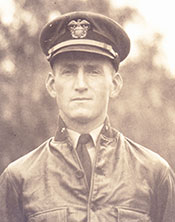PILOT LOG BOOKS
BACKGROUND Emile Choureé was a U.S. Navy pilot born in 1894. He was designated Naval Aviator #1591 in 1918 and married Catherine Davis in 1920. He was a career Navy officer, achieving the rank of Lieutenant Commander. He participated with Navy teams at the National Air Races where he served as the announcer at Naval aerobatic performances. He also flew support aircraft for the team, carrying mechanics and other support personnel, as well as tools and spares. He died in an air crash at Scott Field, East St. Louis, IL in January, 1938. He had two children. They and his wife survived him. A ship, the U.S.S. Choureé (ARV-1), posthumously was named after him. It was launched about a year before the end of WWII, on May 22, 1944, about six years after his passing. He collected and left behind a significant number of photographs, documents and memorabilia related to his naval career and personal life. These items are exhibited in the DOCUMENTS, OBJECTS, PHOTOGRAPHS, PILOT LOG BOOKS and SCRAPBOOKS sections of his Collection.
We have six of his pilot logs, spanning July, 1918 to January, 1937. They are shown fanned in the image below.
Emile Choureé Pilot Log Books, July, 1918 to January, 1937
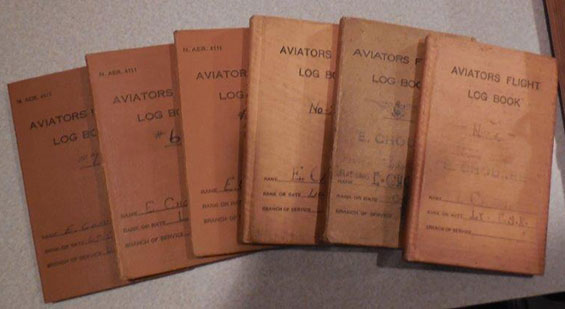 |
Notably missing is a seventh log book for April, 1928 through September, 1930. This significant book would include his landings at Tucson, and his flights to and from the National Air Races (NAR) those years. This is a critical outage for our purposes. If you know the whereabouts of that log book, please let me KNOW.
THE BOOKS
LOG ONE: Choureé's first pilot log records his flights from July, 1918 to November, 1922.
You may download (PDF 4.5Mb) the entire book at the link and follow along as I describe some of the highlights of his flight experiences during these years. He was promoted twice, as he indicated on the cover of the log, on which he identified himself first as Ensign, then crossed that out replaced it with Lieutenant JG, then Lieutenant.
Burgess N-9H (Source: aerofiles.com)
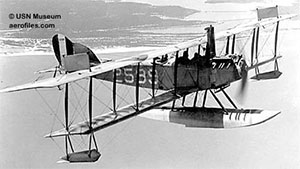 |
Inside the cover on the fly leaf he noted that this log covered his assignments at Naval Air Stations Key West, FL, Miami, FL, Pensacola, FL and Coco Solo, Canal Zone. His first assignment was at Key West, where, on July 7, 1918, he made his first training flight in A-1024 (not a Register airplane), a single-engine Burgess N-9 similar to the one pictured at left, courtesy of the USN via aerofiles.com.
As far as I can determine, this was his first flight in any airplane. This is significant in that record of his his first solo flight followed on July 30th with only about nine total flight hours under his belt. For the next 40 hours he flew the N-9 model at Key West, solo and with passengers, performing standard flight maneuvers, and practicing aircraft/ship coordination. His highest altitude was 6,100 feet.
Curtiss HS-1 (Source: aerofiles.com)
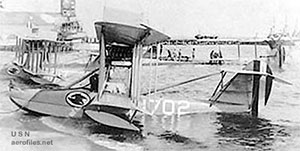 |
In August he moved to Miami, FL, where on the 19th he flew the Curtiss HS-1 for the first time, transitioning quickly to the HS-2 as shown at right from aerofiles.com. Unlike the Burgess with pontoons, the HS-2 was a single-engine flying boat.
According to his log, he remained in Miami only about a week before being transferred to Pensacola. He had logged about 56.5 flight hours.
Curtiss HS-16 (Source: aerofiles.com)
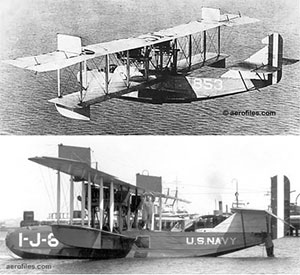 |
At Pensacola, he initially spent a lot of time in the N-9 as gunnery and camera pilot. In October, 1918 he stepped into the larger, twin-engine, Curtiss H-12 and H-16, two examples of which are shown at left, courtesy of aerofiles.com. He flew about a dozen hours in them before returning to intensive training in navigation and gunnery work in the N-9 through January, 1919.
In February, 1919 he transferred to Coco Solo, C.Z., after logging about 250 flight hours. His first flight in Panama was on March 13th in an HS-2.
His training at Coco Solo increased in complexity, including anti-submarine and convoy problems, target towing, radio work and pigeon releasing (a marked contrast in communication technologies!), dropping live Mark IV bombs, and cross-country flying up and down Central America and across the Isthmus.
His last flight at Coco Solo was on August 23, 1920. He was transferred to San Diego and logged his first flight there on September 30th. Of interest, on November 16th he flew a-5718, a Martin MT version of the Martin MB-1 operated by the U.S. Marine Corps. On December 1st, he was assigned to the Naval Detachment at March Field, Riverside, CA for about a month. In 1921 he was back at San Diego and made several cross-country flights to Long Beach, CA and back.
Of particular interest near the end of this log is a flight on May 9, 1921 during which he escorted then Lt. Commander Marc Mitscher. This was about two months before Mitscher's promotion to Commander. Mitscher signed Choureé's log on the facing page (see PDF page 46). There was no authorization stamp or any official data that suggested this was an official sign-of for performance or recertification. Perhaps the pencil signature was just an autograph. Indeed, just two years earlier, Mitscher was one of three Navy pilots who flew NC aircraft for the first time across the Atlantic Ocean. Mitscher landed short of mainland Europe, coming to a sea off Portugal near the Azores archipelago. Postcard photos of the launch of the trans-Atlantic flight are found in one of Choureé's scrapbooks at the link at the top of the page. Choureé's last flight logged in this book took place on November 13, 1922. He had accumulated 1,514 flight hours. A partial chronology of his travel between assignments was tabulated in the rear flyleaf, below.
Emile Choureé Pilot Log Book Number One, Table of Transportation Between Assignments
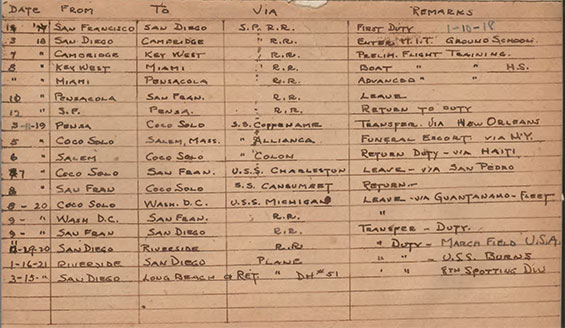 |
---o0o---
LOG TWO: Choureé's second pilot log records his flights from October, 1922 to April, 1925.
Curtiss HS-2L (Source: Web)
 |
You may download (PDF 4.2Mb) the entire book at the link. There is a one-month overlap between the early entries in this log and the final entries in book one. From December, 1922 through June, 1923, he logged mostly routine training, spotting and test flights while assigned aboard the U.S.S. Oklahoma. On June 20-25 he logged catapult shots from the Oklahoma, and on the 26th he recorded, "Detail with Oklahoma completed."
He was transferred to, and began flight duty at, Pearl Harbor near the end of August, 1923. His aircraft was mostly the Curtiss HS-2L A-2054 (not a Register airplane), a single-engine flying boat similar to that pictured at right (Compare it with the HS-1 pictured above).
An important first-flight aviation pioneer also signed Choureé's second flight log. He was John Rodgers, who commanded the first flight across the Pacific Ocean westbound from the U.S. mainland. Rodgers signed the log on PDF pages 16, 17, 23 et al. Unlike Mitscher, Rodgers' signature was official, in that he verified Choureé's flight activities for those periods. Details of Rogers' trans-Pacific flight are at the link. His flight took place about a year after he signed Choureé's book.
Flight log book two is remarkable only in its routine. While he flew several types of aircraft, he worked mostly in amphibious models. He logged his flights mostly by describing them as "5f," or "Flight duty of a class in Par. 5 i." This nomenclature is better understood by referring to a table which Choureé pasted on the inside back cover of his log two, below.
Nomenclature Describing Types of Navy Flights
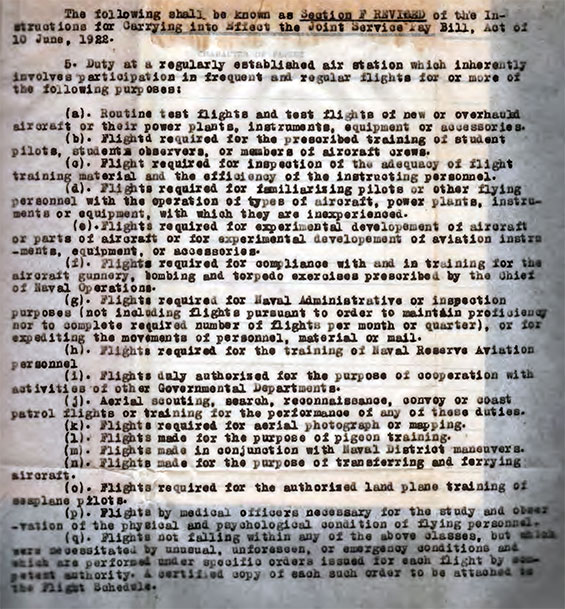 |
We find that "5f" means "Flights required for compliance with and in training for the aircraft gunnery, bombing and torpedo exercises prescribed by the Chief of Naval Operations." "Flight duty of a class in Par. 5 i." meant "Flights duly authorized for the purpose of cooperation with activities of other Governmental departments." Compare this nomenclature with that found at fellow Navy pilot Frederick Trapnell.
---o0o---
LOG THREE: Choureé's third pilot log records his flights from May, 1925 through March, 1928.
Vought VE-7S (Source: aerofiles.com)
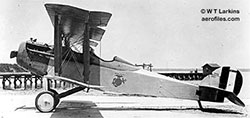 |
You may download (PDF 3.8Mb) the entire book at the link. Choureé started log three with 1886 flight hours. For the first couple of months he flew the Vought_VE-7S, example, right, without pontoons. He then switched to the Curtiss F5-L, a twin-engine amphibian.
On PDF page 5, he notes that he is flying in Annapolis, MD. It is not clear from his log when he relocated from Hawaii. Regardless, through the summer and fall of 1925 he flew more routine flights, but for few hours than he had been flying. For example, he logged only one hour and fifty minutes during the month of August
November (PDF page 10) showed a change of routine. He began "Post Graduate Education," which involved many brief flights in the Vought UO-1 and UO-2. This routine persisted through May, 1926 when he was transferred to Squantum, MA and enrolled at M.I.T. He continued flying brief flights in the UO offering instructional flights to Reserve pilots in the UO and Consolidated NY-1 trainer. He also participated in formation and exhibition flights during "Old Ironsides Day" and "Navy Day" celebrations.
Fokker PW-7 (Source: Web)
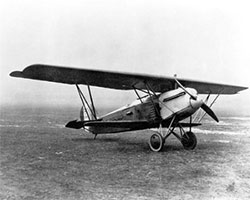 |
In January, 1927 at Boston Airport he noted, "Ice covering entire landing field" (PDF page 25). Those conditions must have been dicey in a light NY-1. He remained in Massachusetts until June, 1927 when he was transferred to Dayton, OH.
In July at Dayton he went aloft quickly in a variety of aircraft, as only McCook and Wright Fields could provide. He logged his first flight in the Fokker PW-7, left.
He immediately familiarized himself with the midwest by taking a cross-country trip from Dayton to Cleveland, OH and return. Later he flew from Dayton to Lakehurst, NJ to Philadelphia and return.
He spent August through September between the Naval Aircraft Factory in Philadelphia and Annapolis, MD. He spent many flights performing "Material tests." He performed qualification flights at sea aboard the U.S.S. Langley in UO and Boeing FB aircraft. Then he transferred back to San Diego, CA in December, 1927.
Boeing_F2B1 (Source: DPL)
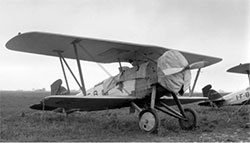 |
One of his first flights at San Diego was to Long Beach, CA where he carried Register pilot Earl Daugherty on what appeared to be a training flight (December 12th, PDF page 37). His monthly flight hours tripled with the move back west. He flight tested aircraft, performed photograph and target tow assignments and flew cross-country as far north as Vancouver, WA and back.
In mid- March, 1928, Choureé landed aboard the U.S.S. Saratoga in a Boeing F2B1, right, courtesy of the Denver Public Library Digital Collection (DPL). Interestingly, the Boeing in this image carries fuselage markings of the "High Hats," the Navy performance team that Choureé accompanied through Tucson. The airplanes shown, A-7443 and A-7455 were not among Register listings.
Thus ends his third log book in March, 1928. He had accumulated 2116.8 flight hours.
---o0o---
LOG FIVE: Choureé's fifth pilot log records his flights from October, 1930 to October, 1933.
Cover of Pilot Log Book Five
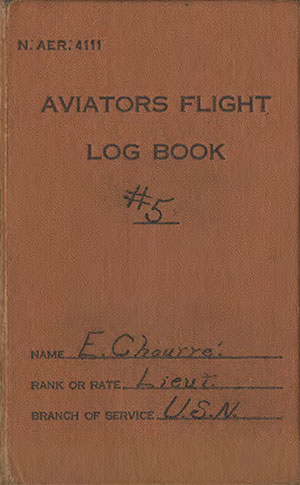 |
You may download (PDF 4.3Mb) the entire book at the link. At left, the cover of log book number five. Notice the missing log book number and the 31-month gap between the start date of log book five (October, 1930) and the end of log book three (March, 1928).
This is a serious and unfortunate outage in the continuity of Choureé's aeronautical record, since the gap leaves us without knowing about the flights he logged for his trips to the 1928, 1929 and 1930 National Air Races (held August-September during those years).
And, without log book four, we have no insight into his two landings at Tucson, Monday, August 19, 1929 and on Monday, August 18, 1930 (both in relation to the NAR). If you have any idea where the missing log book four is, please let me KNOW.
About all we can divine about the gap is the total flight hours that were logged. Choureé clearly records his total hours at the end of book three: 2116.8. He also clearly notes the total time brought forward into log five: 2594.0. The flyleaf of his book five records this, below, right. If you do the math, the lost time amounts to 477.2 hours for log book four. What a pity.
Flyleaf, Pilot Log Book Five
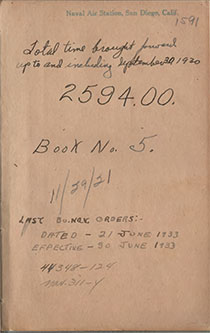 |
Regardless, he is based at San Diego as we begin book five. His first logged flight is in the Sikorsky PS-3 he identified as A-8285 on October 21, 1930.
Uniquely, A-8285 is an aircraft that appears in the Davis-Monthan Airfield Register. It landed at Tucson about a year earlier on Monday, September 23, 1929 at 12:15PM. It was flown by Lt. H.J. Brown carrying two passengers identified as Captain Orr and AMM Thorburn. They were westbound from El Paso, TX to Phoenix, AZ.
Of further interest, Choureé's flights for November, 1930 were certified by fellow Register pilot L.E. Gehres. Also, on December 29, 1930 he carried a passenger he identified as "J. Choureé" in a Keystone NK-1, A-8061. Choureé had two children in 1930, Jeanne and Jack. Jeanne was eight years old and Jack was a months-old infant. Chances are Choureé took his daughter for an airplane ride to celebrate the season. See that flight commemorated on PDF page 5.
Through 1931 he occasionally flew Register airplane A-8457, a Ford 5-AT-C trimotor called the RR-3 by the Navy. It was a trimotor transport. He generally carried upwards of a dozen passengers on these flights, some cross-country to Los Angeles. He gives no reason from his flight log to believe that he flew to the NAR, which were held at Cleveland, OH in the fall of 1931.
On PDF page 24 of this log, Choureé makes note of his civilian Transport license. It was number 5003, renewed to expire February 28, 1933. On PDF page 26 for September, 1932, he recorded, "62 hrs via United Airlines S.D - Cleveland - Oakland. 24 hrs at night." This was not travel on behalf of Navy participation at the 1933 NAR, which was held at Los Angeles that year.
As sometimes happens when I examine the flight logs of Register pilots, I find entries where they cite Tucson as a destination or waypoint, but they neglected to sign the Register on or near the dates of the flights. Such is the case on February 10, 1933 when Choureé flew the Douglas XT3D2 from San Diego through Tucson on his way to El Paso and east. There is no record in the Register of him, his passengers or his airplane, A-8730. This was also the case when he flew the Ford A-8457 through Tucson westbound on February 23, 1933.
The 1933 NAR were held at Los Angeles July 1-4. Choureé's log shows no flights for this time period. That doesn't mean he didn't attend. In fact one of his SCRAPBOOKS documents the 1933 events.
The remainder of his time in 1933 was spent heavy into gunnery flying the Vought O3U. His last flight was October 31st. He logged 2,978.05 total hours to date.
---o0o---
LOG SIX: Choureé's sixth pilot log records his flights from November, 1933 to September, 1936.
You may download (PDF 4.1Mb) the entire book at the link. Based at San Diego, November through January, 1934 were routine. On February 1, 1934 (PDF page 6), he and fellow Register pilot Frederick Trapnell hooked an airplane on the U.S.S. Macon. A photograph at the link documented that flight.
On page 13 of the PDF is another example of where Choureé passed through Tucson but did not sign the Register. On July 12, 1934 he flew the Boeing F4B4 A-9051 (no a Register airplane) through Tucson as part of a trans-continental voyage to Norfolk, VA. He was solo all the way. Interestingly, one stop in his itinerary was Scott Field in Illinois, the place where he would be killed three years later.
Vought SU-3 (Source: aerofiles.com)
 |
The NAR were held at Cleveland August 31 - September 3, 1934. PDF page 16 places Choureé there on August 30th. He had flown from Anacostia to Cleveland on that day in a Boeing F4B-4, A-9226 (not a Register airplane). One of his scrapbooks documents the 1934 NAR.
December, 1934 through March, 1935 he spent a lot of time in the Vought SU-3, left, courtesy of aerofiles.com. Most of the flights were cross-country up and down the west coast. On March 8, 1935, Choureé earned the rank of lieutenant commander.
On August 14, 1935 he became carrier-qualified in the Grumman F2F-1 (A-9672, Model G-8), a carrier-borne, single-seat, biplane fighter (PDF page 27). Below, a 3-view of the Grumman F2F-1 courtesy of the link. The F2F-1 was evolved from the FF-1. Neither of these models ever landed at Tucson. However, eleven landings by FF-1s were logged in the Clover Field Register, Santa Monica, CA, by Navy pilots. Nine of these landings were part of a mass flight on a round trip exercise from San Diego to Mines Field and return.
Grumman F2F-1 Three-View (Source: Link)
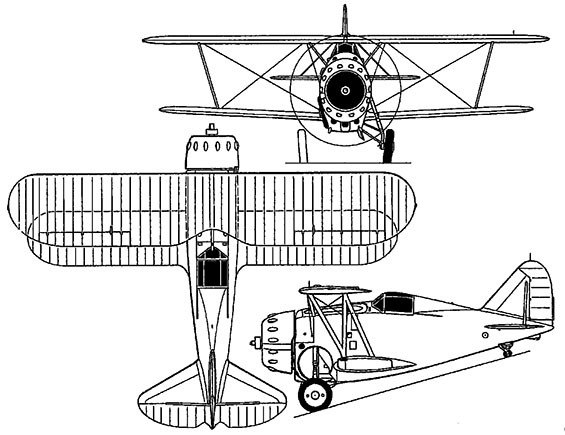 |
From September to December, 1935 Choureé spent most of his flight hours in the SU-3 A-9137 (not a Register airplane) flying cross-country training missions with students and transporting senior officers. His flight activities were certified by then Chief of Staff Aubrey W. Fitch, whose signature appears on several pages in this log book, along with John Towers, who flew the first trans-Atlantic flight with Marc Mitscher, cited above.
Choureé's last flight in this book occurred on September 13, 1936. He finished this log with 3,363.9 accumulated flight hours.
---o0o---
LOG SEVEN: Choureé's seventh and final pilot log records his flights from October, 1936 to January, 1937.
You may download (PDF 1.8Mb) the entire book at the link. Of interest are his first three flights in this book, logged on October 24, 1936. He flew the Register airplane Vought SU-3, A-9068. Indeed, 9068 landed about four years earlier on January 20, 1932. It was identified as a Vought O-3U-2 in the Register. It was later converted to a model SU-3, as Choureé flew it. As far as I could tell, this is the only airplane in any of the his available logs that landed at Tucson.
On PDF page 9, on April 7, 1937, we find another example of a landing by Choureé at Tucson, which does not appear in the Register. Little wonder, because the last entry in the Davis-Monthan Register was made November 26, 1936.
From May, 1937 to January, 1938 Choureé's flights were not extraordinary. Most of his flights were local to the west coast, and most of them were within a couple of hundred miles from San Diego.
His final entry in log seven was made on January 26, 1938. He logged two flights on January 23rd in the Curtiss SOC-3 he identified as A-1069 (not a Register airplane). He and his passenger, Michael Ola cited in the log, were on a cross-country voyage from Anacostia, MD to Dayton, OH. They They flew 5.2 hours, then spent the a couple of nights in Dayton (weather?) before departing for Belleville on January 26th.
They were ferrying 1069 cross-country, presumably to San Diego. Here Choureé's log and the official record reveal something curious. Choureé and Ola were killed on the 26th at Belleville. But on the 26th Choureé actually logged his flight to Belleville after flying 1.7 hours from Dayton. Please download and examine page 18 to review that documentation as shown below.
Emile Choureé Pilot Log Seven, Page 18, January 26, 1938
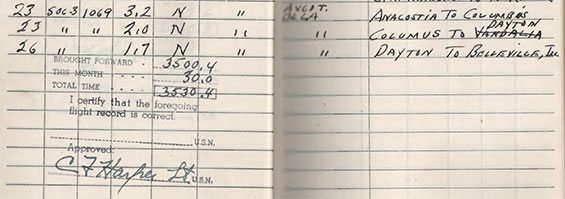 |
Now, the document below, from the U.S. Navy Casualties Book for 1938, states that they were "circling for landing" when they struck a dirigible mooring tower, fell to the ground, demolished their airplane and died.
1938 U.S. Navy Casualties Book (Source: ancestry.com)
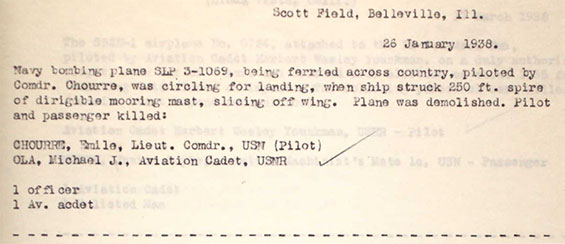 |
However, from his pilot log, it is obvious Choureé was on the ground when he logged his 1.7 hour flight from Dayton to Belleville (his annotation is in the same handwriting that appears throughout his log books). We're left thinking that probably the crash didn't occur on their initial arrival at Belleville as suggested in the Navy Casualties Book. We could conclude that Choureé probably landed, fueled, made his log entry and departed with Ola on the next leg of their journey. At that point, perhaps due to poor visibility either from weather, or from the portly dimensions of the SOC, he didn't see the mooring tower during his climbout from the field. We'll probably never know, given that it was over seventy-seven years ago as of the upload date of this page.
Regardless of how his life ended, we know he had accumulated 3,530.4 flight hours up to his final flight, as efficiently attested to by Register pilot Lt. C.F. Harper.
BACK TO TOP
BACK TO THE COLLECTION
---o0o---
THIS PAGE UPLOADED: 06/16/15 REVISED:
|

